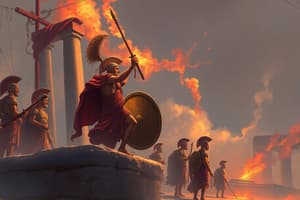Podcast
Questions and Answers
What was a fundamental factor driving warfare in Ancient Greece?
What was a fundamental factor driving warfare in Ancient Greece?
- Desire to expand territories into neighboring empires
- Prevailing beliefs about honor and glory
- Religious differences between city-states
- Competition for resources and power (correct)
Which of these innovations significantly changed Ancient Greek warfare?
Which of these innovations significantly changed Ancient Greek warfare?
- The adoption of iron weaponry, making it more affordable. (correct)
- The invention of the catapult, a powerful siege weapon.
- Development of advanced armor made from steel.
- The introduction of gunpowder weapons.
What was the primary function of the hoplite phalanx in Ancient Greek warfare?
What was the primary function of the hoplite phalanx in Ancient Greek warfare?
- To swiftly maneuver and outmaneuver enemy forces in open battlefields.
- To engage in individual combat and showcase warrior skills in close-quarters fighting.
- To provide a shield wall for protection and enable coordinated spear attacks. (correct)
- To launch surprise attacks on enemy encampments using flanking maneuvers.
What was the primary reason the hoplite phalanx was considered highly effective?
What was the primary reason the hoplite phalanx was considered highly effective?
Why did the development of triremes have a significant impact on warfare in Ancient Greece?
Why did the development of triremes have a significant impact on warfare in Ancient Greece?
What was a major difference between the military structures of Athens and Sparta?
What was a major difference between the military structures of Athens and Sparta?
What does the presence of siege weaponry, like battering rams and catapults, indicate in Ancient Greek warfare?
What does the presence of siege weaponry, like battering rams and catapults, indicate in Ancient Greek warfare?
How did the development of iron weaponry impact Ancient Greek warfare?
How did the development of iron weaponry impact Ancient Greek warfare?
Flashcards
Hoplite Phalanx
Hoplite Phalanx
A tightly packed formation of heavily armed infantry, primarily consisting of citizen-soldiers in Ancient Greece.
Hoplites
Hoplites
Citizen-soldiers in Ancient Greece who were equipped with bronze or iron armor, a spear and a sword.
Hoplite Warfare
Hoplite Warfare
The primary focus of Ancient Greek warfare, involving close combat and the coordinated use of spears and shields.
Triremes
Triremes
Signup and view all the flashcards
Athenian Navy
Athenian Navy
Signup and view all the flashcards
Spartan Military
Spartan Military
Signup and view all the flashcards
Siege Warfare
Siege Warfare
Signup and view all the flashcards
Iron Weaponry
Iron Weaponry
Signup and view all the flashcards
Study Notes
Warfare in Ancient Greece
- Warfare was central to Greek city-state (polis) life, driven by competition and resource needs.
- The Greek military constantly adapted, responding to evolving societal needs and enemy tactics.
- The hoplite phalanx, a tightly-knit infantry formation, dominated military engagements in the Archaic and Classical periods.
- Hoplite equipment costs reflected the societal importance of citizen-soldiers, demanding economic stability and land ownership within the polis.
- Naval warfare, particularly in the Aegean Sea, was crucial. Triremes, fast and maneuverable ships, were vital for controlling maritime trade and coastal areas.
Hoplite Warfare
- Hoplites were citizen-soldiers, armed with bronze or iron armor, a spear (dory), and sword (xiphos).
- The phalanx formation created a shield wall, protecting soldiers and delivering coordinated spear attacks.
- Discipline, training, and cohesion were essential for phalanx success. A broken formation could result in a rout.
- Hoplite warfare focused on close-quarters combat, prioritizing collective action.
- Tactical approaches varied based on specific military and political contexts, adapting over time to counter enemy strategies.
Athenian and Spartan Military Structures
- Athens, a democracy, built a strong navy due to its maritime trade.
- Sparta, a militaristic society, prioritized a highly-disciplined hoplite army, emphasizing rigorous training.
- The Athenian and Spartan military systems reflected the unique societal values of each polis.
- Different emphases, naval power versus ground forces, shaped military strategies.
Military Technology and Innovations
- Bronze weaponry dominated early Greece, representing advanced technology.
- Iron weaponry's later development lowered costs, making equipment more accessible to soldiers.
- Innovations in ships and naval tactics were crucial to maritime warfare.
- Siege weaponry, including battering rams, catapults, and siege towers, enhanced military capabilities during city sieges.
The Impact of Warfare on Greek Society
- Warfare profoundly shaped Greek culture, values, and political systems.
- Conflicts and foreign involvement significantly altered the structure and dynamics of many city-states.
- The impact of warfare varied, affecting different city-states' economic resources, and influencing political alliances.
- Military service as a civic duty strengthened the connection between individuals and their polis.
- This civic duty concept was firmly embedded in their society and politics.
Studying That Suits You
Use AI to generate personalized quizzes and flashcards to suit your learning preferences.




